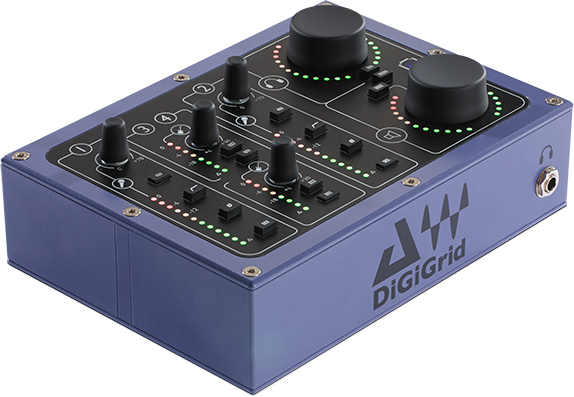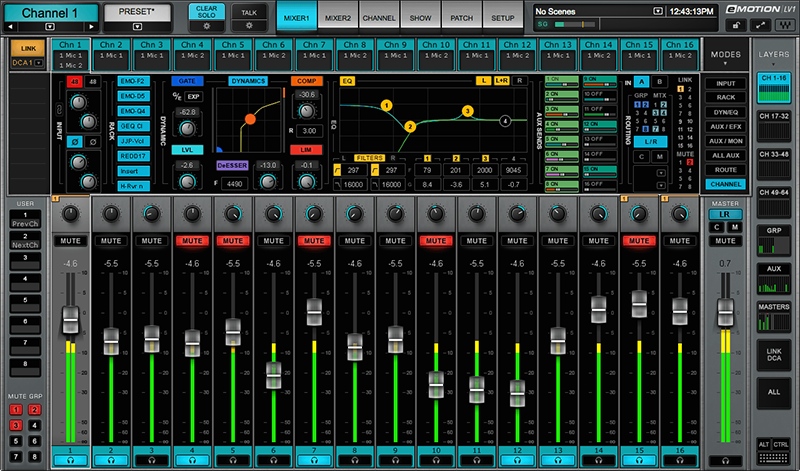Demystifying Waves’ DiGiGrid: Can It Enhance the Way you Work in the Studio or on Stage?

Waves’ DiGiGrid D, released earlier this year began to bring DiGiGrid’s capabilities out of the rack and onto the desktop.
Are you familiar with the still relatively new Waves DiGiGrid or SoundGrid systems?
Since these platforms were first released in 2013 and 2014, they seem to be catching on with some of the industry’s biggest players including Henry Sarmiento [Lady Gaga, 50 Cent, Akon], Jack Joseph Puig [U2, Lady Gaga, Black Eyed Peas, John Mayer], and Peter Keppler [David Bowie, Nine Inch Nails, Katy Perry].
We covered the release of the rackmount-ready DiGiGrid DLS interface last year and more recently, the announcement of Waves’ new portable line, the DiGiGrid Cube series, released earlier this year.
With larger Waves DiGiGrid interfaces like the DLS catching on in pro studios and large scale venues, and a new portable line nearing on the horizon, we decided to sit down with Luke Smith from Waves, to talk us through some real world applications for this novel platform.
If the idea of using Waves plugins live, running Waves plugins off the built in DSP of a DiGiGrid interface, or linking multiple computers together and sending audio and MIDI information between the two appeals to you, read on!
Hey Luke. So, the first question is pretty straightforward: Who are you and what do you do at Waves?
So I’ve been working for Waves for about 5 years now as the sales manager for the pro division and the live division in North America. We call sales managers and all of our sales guys “Waves Specialists” and that means we’re all very well-versed in the product—and it’s a deep product line. We’re all out there giving pre and post-sales support and making sure that the stuff works the way that the users want it to work. It’s much more than just a sales gig.
So you guys released the larger DiGiGrid IOS a little over a year ago. What is the new Cube series doing that the DiGiGrid IOS series can or can’t do?
Well that’s a good question. All of the DiGiGrid products use the Waves SoundGrid audio over ethernet protocol to connect to your computer. So that means they’re all ethernet-based audio interfaces.
Unlike USB or Firewire—or even PCI based audio interfaces—ethernet-based interfaces can be very flexible. So with the first products that came out in the DiGiGrid line, they all had a lot of inputs and a lot of outputs.
We got a lot of feedback and we wanted to add to the existing product line to make smaller boxes; just smaller interfaces that people could still utilize all of the flexibility and cool stuff that we can do on ethernet, but not have to pay for 8 inputs and 8 outputs if they don’t need it.
So that’s really the idea behind the cubes: They’re using the same protocol and the same software to connect to your computer and to your DAW. They’re just smaller and more affordable.
I hear you’ve seen the DiGiGrid series being used for live sound, studio work, broadcast and production studios. Can you talk about how someone in live sound would use the interface differently than someone using one in a recording studio?
Totally. You know the confusion about DiGiGrid so far—we’re working on better marketing content to make sure that people can get to the specific thing that they want to know how to do after buying the system. We’re working on making that better with new content in the near future.
As far as the confusion about whether to use them in the studio or live, it is partly because they’re flexible enough to use them in both fields. There really aren’t any limitations to them. When you buy a DiGiGrid IOS, you have just bought 8 mic/line inputs for your recording studio, but you’ve also just bought 8 mic/line inputs for the new Waves LV1 mixing console. That’s a new system that people are using to build their own Waves digital mixing consoles and actually use them in FOH or monitors.
So with the IOS, you can use it with the LV1 software and actually create a console. You can also use it with the MultiRack [plugin host] software that’s been out for several years, and it’s what you use if you want to run Waves on a Yamaha, Soundcraft, Allen & Heath console, Studer, the list goes on and on.
So the MultiRack application is just a plugin host—it is a bunch of virtual racks that has 8 plugins per rack and you can use the IOS on a digital or even an analog console to run Waves plugins!
The other beauty of the IOS is that in addition to having the 8 mic/line outputs, it has built-in DSP. Currently, the only 2 DiGiGrid interfaces that also have Waves SoundGrid DSP built right in are the IOS and the DLS.
The IOS, since it has the DSP and the I/O built in… you can use it with LV1 [software mixer], you can use it with MultiRack [plugin host platform], and you can use it to provide DSP for any DAW in the studio. So that’s what we try to get people to understand. We feel like this is the most flexible DSP+ audio interface you can buy because you can use it live and in the studio.
It’s a great idea to be able to share the same interface live and in the studio. One of my favorite features of the interface is the ability to link up two computers using an IOS so, if I like to work in Logic and my co-writer preferred using Ableton or Pro Tools, we could link our computers together and record from one to the other rather seamlessly.
It’s funny—we notice that once people get into the DiGiGrid system, they start to explore what you can do.
In order to allow two computers connected to the same interface, you can do that very easily with the 2nd, 3rd, or 4th ethernet port that’s built into the IOS.
When you have it properly connected to your main computer, you can actually plug an ethernet cable from the interface to a second computer… to take advantage of our core audio or ASIO drivers, so you can actually take advantage of up to 128 outputs… and patch it from one computer to the next with no additional interface—just an ethernet connection! So that’s really hip for a lot of reasons.
Even with the Audio/MIDI setup built right into the Mac OS, you can sync say, an Ableton Live transport and slave it to your Pro Tools session on your first computer. When you press play on Ableton Live, you’ll see however many inputs you patched into Pro Tools and you’ll actually be able to print the audio onto your Pro Tools rig because the 2 transports are linked up over the same ethernet connection.
So really, what we’re talking about here is getting rid of that 2nd interface and getting rid of the need for line inputs on your main rig [when] people walk in with other computers and you have no better way to get it into your main rig than recording analog. That’s the point of this. Just an ethernet cable [to connect one system to another]!
And compared to other cables like Thunderbolt, ethernet is still relatively affordable, right?
It is. You know, I’m glad you brought that up too, because there’s been a lot of marketing-speak surrounding Thunderbolt.
The reason we went with Ethernet is very simple: We want this to be as accessible to people as possible, just like our plugins. In order to do that, and in order for us to manage the latency the way we do, to continue to be flexible, and also be able to easily work on a Mac or PC, we consciously chose to go on gigabit ethernet.
We get the question, “Oh, so you’re not Thunderbolt compatible?” and that could not be further from the truth. There’s a $30 adapter that does Thunderbolt to gigabit ethernet and with that, you’re Thunderbolt ready. If you’re on the PC side and you don’t have a physical connection, you can buy a USB 3.0 to ethernet adapter and you’re good to go.
It will be the same speed too!
Exactly! It doesn’t slow down the connection at all.
So the other concern is that while my main computer—a 2011 MacBook Pro—has a physical ethernet connection, the newer ones don’t. Do you ever get any questions about whether ethernet cables will be harder to find in the near future?
We’re betting on that not being the case, and it’s not because we don’t have any concept of reality about how many users we have vs. how many corporations have ethernet-based storage solutions. Ethernet as a physical cable isn’t going anywhere because the infrastructure that we’ve built on it—from internet servers to closed private network systems for huge corporations—it’s just too widely used at this point.
So we’re betting on it not going the way of Firewire or some of the older protocols out there because it’s been around for this long and it’s really easy to scale the same physical connector from a 1 gigabit network to a 10 gigabit network whenever we need it to happen. Do I know what’s going to happen in the future? Probably not, but we’re betting on the fact that ethernet is going to be around for a long time.
Going back to live sound use for a second, I’ve been to demonstrations where the LV1 mixer is being run off a touchscreen computer. Is there any hardware for the LV1 mixer that allows for physical faders yet?

The Waves LV1 Mixing Console allows for a quick and efficient workflow in demanding live sound situations.
LV1 is literally just a new software application that runs on your computer that only utilizes SoundGrid DSP engines to process and pass audio, and it only uses SoundGrid-compatible I/O devices as the mic pres or whatever types of inputs and outputs you would need on the console.
What’s cool about that is that you can turn your existing hardware into a console.
You [can] configure and purchase LV1 just like you would purchase any other large format mixing console, taking into account what type of I/O you need, how much DSP you need to run all the channels on the desk, and what type of control surface you want.
Currently, the control surface options—and the I/O options of LV1—are deliberately not exclusive. They’re open. We are approaching a lot of different companies to make SoundGrid-compatible I/O devices and SoundGrid-compatible control surfaces.
Right now, LV1 exists only using DiGiGrid I/O’s but in the future, companies like Apogee and Burl will have their SoundGrid cards available and you will be able to make a hybrid console that might have some Apogee mic pres, some DiGiGrid mic pres, and some Burl mic pres.
The same concept applies on the control surface side: Right now, we are working with our first partner to release a dedicated control surface for LV1. That company is Peavey. They’re working on a USB-based control surface that is directly integrated into LV1. Hopefully we will see that in the next couple of months.
Until that comes out, the good news is we built the MCU Huey protocol into the application so if you have a Behringer X-Touch, an SSL Nucleus, an Avid Artist Mix, or even a Mackie Control Universal, you can connect that to LV1 and get physical faders.
So to be clear, there are physical fader options now. What we are waiting for now is for more dedicated control surface options that directly integrate into LV1 as opposed to using the Mackie protocol.
Could you talk to us a bit about the low latency of the DiGiGrid interfaces?
Yeah, one of the biggest misconceptions about how the DSP part of DiGiGrid and SoundGrid works is due to the other companies that were already doing DSP for your interface already.
What we want to be very clear about is that when [engineers are] interested in using the DSP of the interface, they can do so directly from their DAW without having to open an external application.
The misconception is “Oh, so in order for me to use a low latency DSP plugin, I have to use it in their Waves mixer application” and that’s not true. The StudioRack plugin is really cool and it works in any DAW!
So, in any DAW, if I wanted to get Waves DSP to happen, then every time I pulled out a StudioRack plugin and the DSP engine was attached properly to the computer, I would burn 1064 Waves DSP voices. And that’s really cool because in addition to the I/O the core audio driver gives you, it also gives you these Waves DSP voices.
That’s awesome because you have 64 instances of StudioRack that you can pull up and offload onto your DSP engine directly from your DAW mixer. The other cool thing is that we encourage people who are on DiGiGrid to go to the highest buffer size their DAW will allow and work there from the very beginning. What that means from a workflow standpoint, is that hopefully you will never run into a native “wall” as you’re working, adding tracks and creating music.
If you get to the point where you have 30, 40, 50 tracks with a ton of plugins and you realize you need to do an overdub, then StudioRack can switch from playback to input mode and it will allow you to listen to the input, track and record arm… you’re still in your DAW, you’re still at a low buffer size, but you’re listening to a Waves DSP plugin and you’re mixing that input and you’re getting it to sound better so you can overdub and you don’t have to kill half of your audio tracks just to play the session back.
It’s the best of both worlds: Stay in your DAW. Stay at a really high buffer size and if you need to do an overdub and you still want to mess around with Waves DSP plugins on that input, switch StudioRack to input mode and [record]. The DSP aspect of how it works with our system is very cool, but to be clear, you don’t need it. They work great as audio interfaces without DSP. It’s just something cool to do if you want it.
In terms of latency, we just ran a guitar through an IOS and MacBook and used Amplitube 4 to get a really low buffer size of 16. We heard no clicks or pops and experienced virtually no latency. Can you talk a bit about the quality of the mic pres?
In order to create the DiGiGrid company, Digico, the live sound leader in mixing consoles, and Waves partnered together. So DiGiGrid mic pres and converters are Digico mic pres and converters.
Any final thoughts?
The last thing that I’ll mention is SoundGrid Connect, which is cool because it allows you to use our DSP engines with another audio interface.
We understand there are a lot of different companies making audio interfaces out there and we’d love you to jump on board with us, but if all you’re looking for is to add Waves DSP to your interface, well now you’re able to do that with SoundGrid Connect. You’ll see your interface show up in our software driver, SoundGrid Studio, and you’ll see our built-in DSP engine attached, so all that cool StudioRack stuff (aside from input mode) will be there. You now have a way of offloading your Waves plugins to DSP and continue to use your own interface.
The SoundGrid DSP platform is a plugin format and a DSP platform that we’re asking other companies to code their plugins to. So Plugin Alliance and Flux are already available, and hopefully [soon] Sonnox will be available too. That means that when you buy a SoundGrid DSP engine you are not only limited to only using Waves plugins on that DSP engine, and we’ll see more manufacturers jump on board very soon.
Please note: When you buy products through links on this page, we may earn an affiliate commission.








